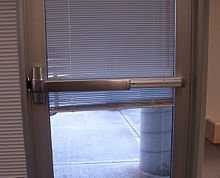- Crash bar
-
A crash bar (also known as a panic bar, exit device,[1] panic device,[2] or a push bar) is a mechanism for unlatching a door, consisting of a spring-loaded metal bar fixed horizontally to the front of the door (the side of the door that opens outward) and hinged. It is operated by pushing on it, which unlatches and opens the door.[1]
Many countries' building codes require them on all fire and emergency exits. They are so named because they can be operated by someone "crashing" into them; the alternate term "panic bar" implies a similar meaning. In the UK, British Standards EN179 and EN1125 apply to panic hardware for workplace access and public access buildings respectively.[3]
Many of these doors are one-way, and cannot be opened from the outside. To use this device on a two-way door, another type of door handle must be mounted on the opposite side.
The idea was first put into practice after the events of the Victoria Hall disaster in Sunderland, England in 1883.[citation needed] It saw widespread use after the Iroquois Theater Fire in Chicago, USA, which killed 602 people on December 30, 1903[citation needed], and the Italian Hall Disaster on Christmas Eve 1913 (popularized by Woody Guthrie's song, "1913 Massacre").
References
- ^ a b American National Standards Institute, ANSI/BHMA A156.3-2001, American National Standard for Exit Devices
- ^ California Code of Regulations, Title 24, Part 2, "California Building Code." 1008.1.9
- ^ http://www.doorstuff.co.uk/ph/phen.htm British Standards relating to Panic Hardware
Categories:- Door furniture
- Fire protection
- Architectural element stubs
Wikimedia Foundation. 2010.

